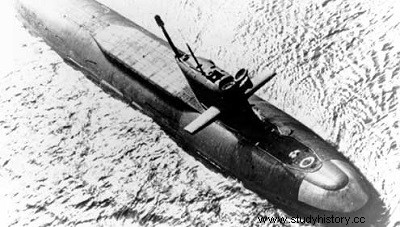
The nuclear missiles of the five French submarines in service or under construction externally resemble the Polaris. Their range is 1,900 miles.
Russia, to begin with, took quite a different policy from the United States in that its first ballistic missile submarines were diesel -electric which had to emerge partially to launch their missiles. These then had a range of 200 to 300 miles. This type of submarine continued to be manufactured in the Soviet Union for a few years, although the first nuclear-powered vessels were completed between 1958 and 1961.
It was only in 1967, seven years after the entry into service of the George Washington, the first nuclear-powered ballistic missile submarine was completed in the Soviet Union. It inaugurated the “Yankee” class and could launch sixteen missiles under water carrying 1,350 miles.
It seems that the Russians had some difficulty in adapting their submarines to these long-range missiles . This is why a new series called "Delta", but derived from the "Yankee" class, was announced in 1972. Its buildings carry 12 missiles carrying 4,000 miles. It is believed that the Russians intend to build at least 45 ballistic missile submarines of these two classes.
If their high speed and the great depth to which they can dive put the pennies atomic marines safe from attacks by surface ships, they can be countered by nuclear-powered attack submarines, also called submarine hunters. This is because the enormous power developed by their reactor makes it possible to equip these submarines with an underwater detection system by Sonar infinitely more powerful than any that can be installed on surface ships.
Furthermore, the waves emitted by the Sonar of a surface ship must necessarily pass through the water at a fairly acute angle. This means that temperature variations at different depths can perfectly reflect Sonar waves, allowing a submarine that is under the "thermal layers" to escape detection.
